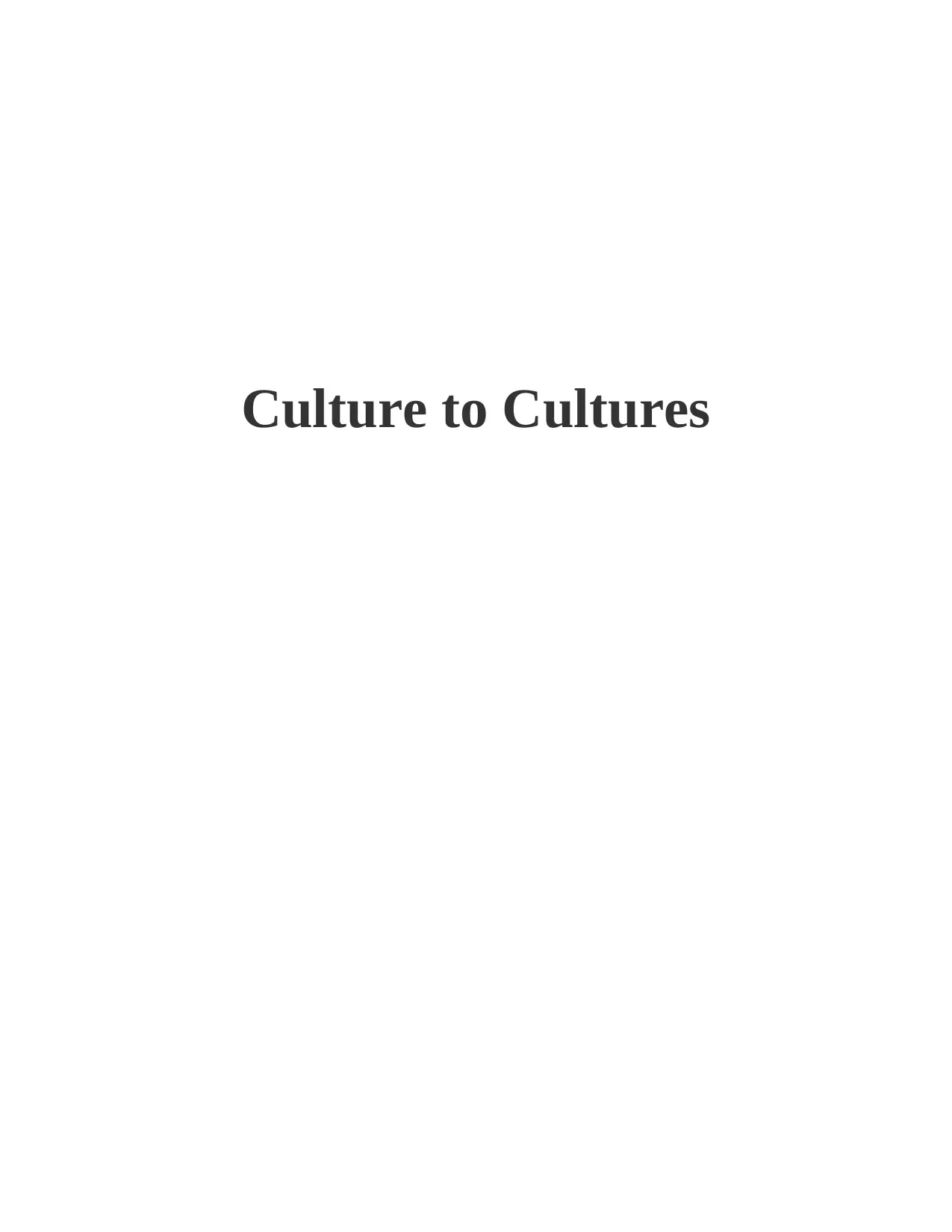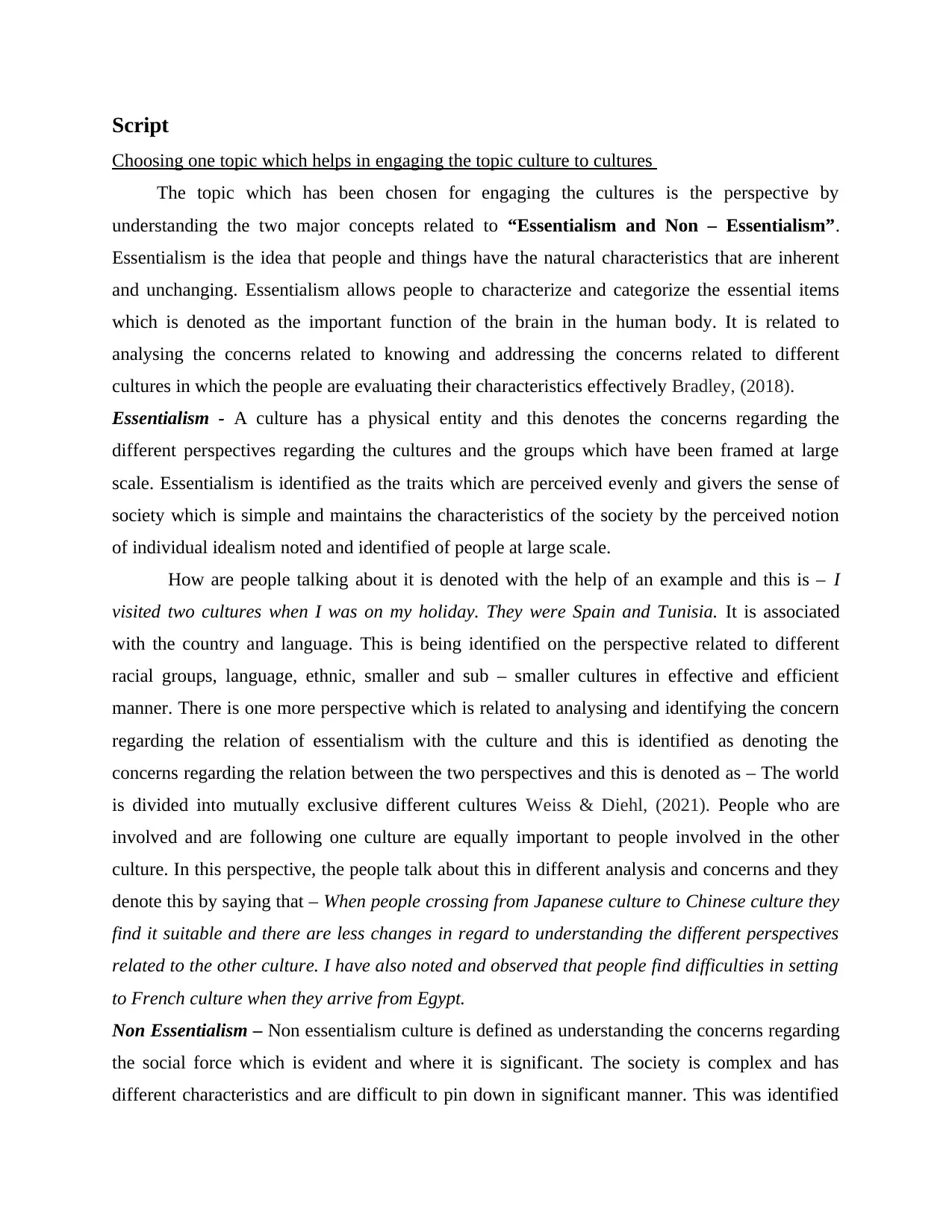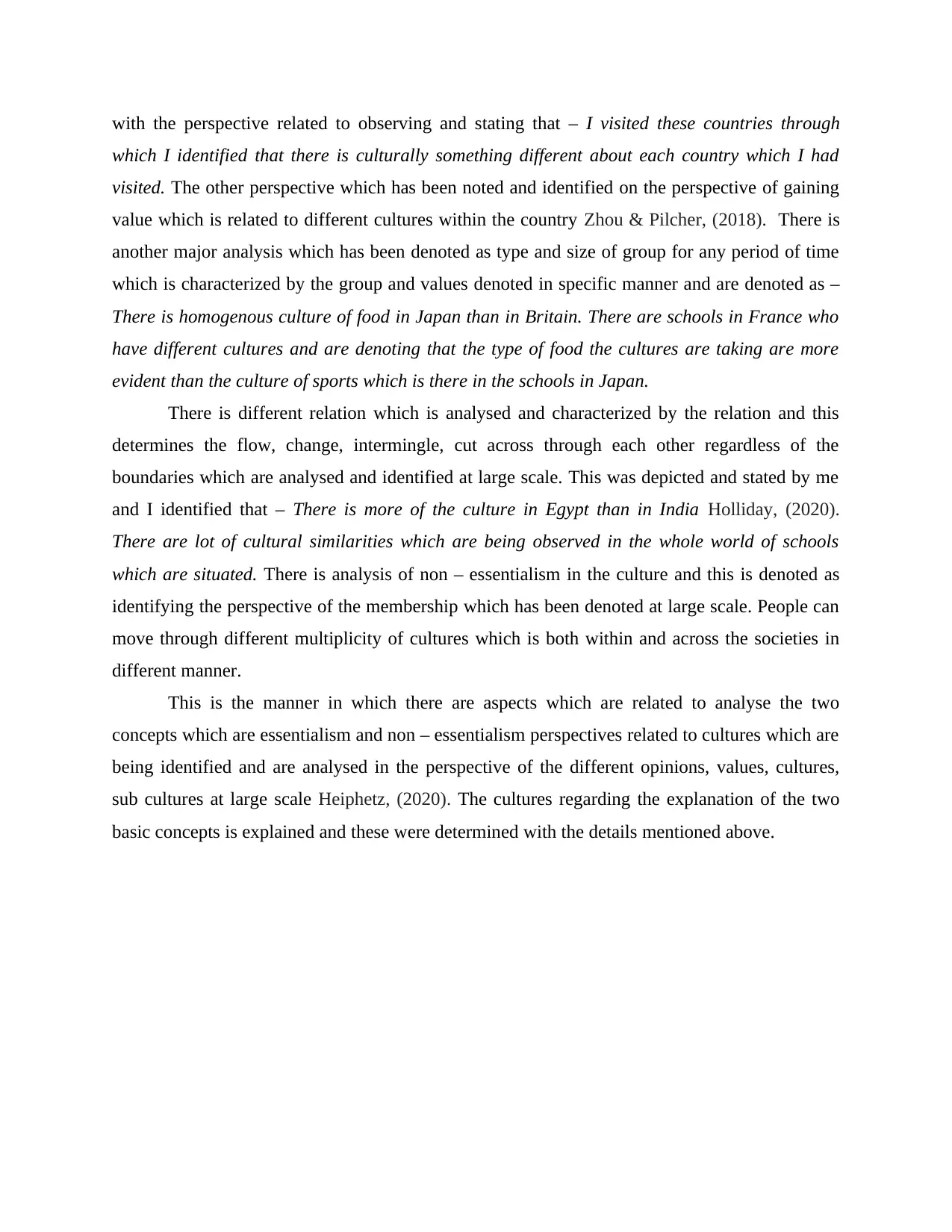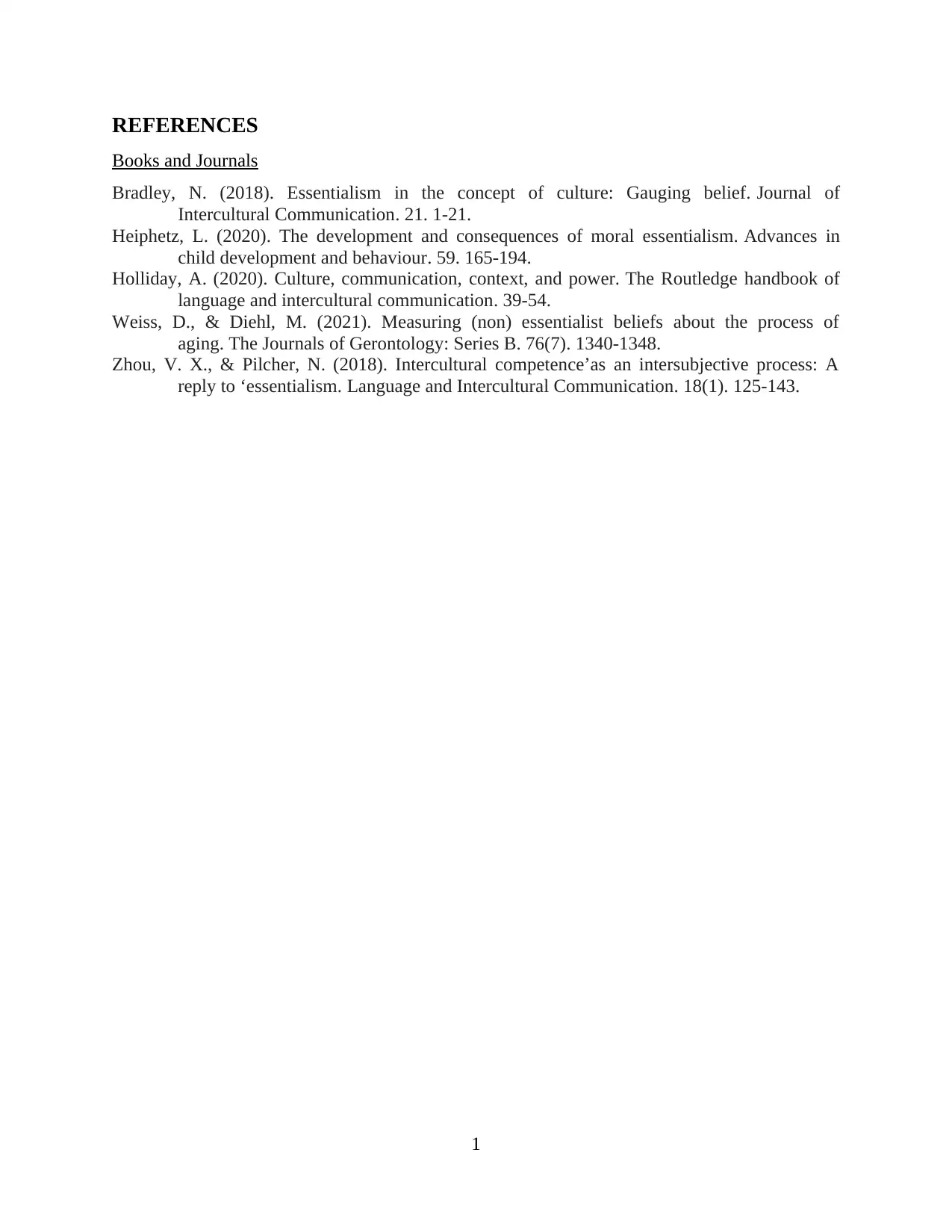Essentialism and Non-Essentialism Perspectives on Cultures
VerifiedAdded on 2023/06/07
|5
|1022
|287
AI Summary
This article explores the concepts of essentialism and non-essentialism in relation to cultures. It discusses how these perspectives shape our understanding of different cultures and provides examples to illustrate the differences between the two.
Contribute Materials
Your contribution can guide someone’s learning journey. Share your
documents today.

Culture to Cultures
Secure Best Marks with AI Grader
Need help grading? Try our AI Grader for instant feedback on your assignments.

Table of Contents
Script................................................................................................................................................3
Choosing one topic which helps in engaging the topic culture to cultures.................................3
REFERENCES................................................................................................................................1
Script................................................................................................................................................3
Choosing one topic which helps in engaging the topic culture to cultures.................................3
REFERENCES................................................................................................................................1

Script
Choosing one topic which helps in engaging the topic culture to cultures
The topic which has been chosen for engaging the cultures is the perspective by
understanding the two major concepts related to “Essentialism and Non – Essentialism”.
Essentialism is the idea that people and things have the natural characteristics that are inherent
and unchanging. Essentialism allows people to characterize and categorize the essential items
which is denoted as the important function of the brain in the human body. It is related to
analysing the concerns related to knowing and addressing the concerns related to different
cultures in which the people are evaluating their characteristics effectively Bradley, (2018).
Essentialism - A culture has a physical entity and this denotes the concerns regarding the
different perspectives regarding the cultures and the groups which have been framed at large
scale. Essentialism is identified as the traits which are perceived evenly and givers the sense of
society which is simple and maintains the characteristics of the society by the perceived notion
of individual idealism noted and identified of people at large scale.
How are people talking about it is denoted with the help of an example and this is – I
visited two cultures when I was on my holiday. They were Spain and Tunisia. It is associated
with the country and language. This is being identified on the perspective related to different
racial groups, language, ethnic, smaller and sub – smaller cultures in effective and efficient
manner. There is one more perspective which is related to analysing and identifying the concern
regarding the relation of essentialism with the culture and this is identified as denoting the
concerns regarding the relation between the two perspectives and this is denoted as – The world
is divided into mutually exclusive different cultures Weiss & Diehl, (2021). People who are
involved and are following one culture are equally important to people involved in the other
culture. In this perspective, the people talk about this in different analysis and concerns and they
denote this by saying that – When people crossing from Japanese culture to Chinese culture they
find it suitable and there are less changes in regard to understanding the different perspectives
related to the other culture. I have also noted and observed that people find difficulties in setting
to French culture when they arrive from Egypt.
Non Essentialism – Non essentialism culture is defined as understanding the concerns regarding
the social force which is evident and where it is significant. The society is complex and has
different characteristics and are difficult to pin down in significant manner. This was identified
Choosing one topic which helps in engaging the topic culture to cultures
The topic which has been chosen for engaging the cultures is the perspective by
understanding the two major concepts related to “Essentialism and Non – Essentialism”.
Essentialism is the idea that people and things have the natural characteristics that are inherent
and unchanging. Essentialism allows people to characterize and categorize the essential items
which is denoted as the important function of the brain in the human body. It is related to
analysing the concerns related to knowing and addressing the concerns related to different
cultures in which the people are evaluating their characteristics effectively Bradley, (2018).
Essentialism - A culture has a physical entity and this denotes the concerns regarding the
different perspectives regarding the cultures and the groups which have been framed at large
scale. Essentialism is identified as the traits which are perceived evenly and givers the sense of
society which is simple and maintains the characteristics of the society by the perceived notion
of individual idealism noted and identified of people at large scale.
How are people talking about it is denoted with the help of an example and this is – I
visited two cultures when I was on my holiday. They were Spain and Tunisia. It is associated
with the country and language. This is being identified on the perspective related to different
racial groups, language, ethnic, smaller and sub – smaller cultures in effective and efficient
manner. There is one more perspective which is related to analysing and identifying the concern
regarding the relation of essentialism with the culture and this is identified as denoting the
concerns regarding the relation between the two perspectives and this is denoted as – The world
is divided into mutually exclusive different cultures Weiss & Diehl, (2021). People who are
involved and are following one culture are equally important to people involved in the other
culture. In this perspective, the people talk about this in different analysis and concerns and they
denote this by saying that – When people crossing from Japanese culture to Chinese culture they
find it suitable and there are less changes in regard to understanding the different perspectives
related to the other culture. I have also noted and observed that people find difficulties in setting
to French culture when they arrive from Egypt.
Non Essentialism – Non essentialism culture is defined as understanding the concerns regarding
the social force which is evident and where it is significant. The society is complex and has
different characteristics and are difficult to pin down in significant manner. This was identified

with the perspective related to observing and stating that – I visited these countries through
which I identified that there is culturally something different about each country which I had
visited. The other perspective which has been noted and identified on the perspective of gaining
value which is related to different cultures within the country Zhou & Pilcher, (2018). There is
another major analysis which has been denoted as type and size of group for any period of time
which is characterized by the group and values denoted in specific manner and are denoted as –
There is homogenous culture of food in Japan than in Britain. There are schools in France who
have different cultures and are denoting that the type of food the cultures are taking are more
evident than the culture of sports which is there in the schools in Japan.
There is different relation which is analysed and characterized by the relation and this
determines the flow, change, intermingle, cut across through each other regardless of the
boundaries which are analysed and identified at large scale. This was depicted and stated by me
and I identified that – There is more of the culture in Egypt than in India Holliday, (2020).
There are lot of cultural similarities which are being observed in the whole world of schools
which are situated. There is analysis of non – essentialism in the culture and this is denoted as
identifying the perspective of the membership which has been denoted at large scale. People can
move through different multiplicity of cultures which is both within and across the societies in
different manner.
This is the manner in which there are aspects which are related to analyse the two
concepts which are essentialism and non – essentialism perspectives related to cultures which are
being identified and are analysed in the perspective of the different opinions, values, cultures,
sub cultures at large scale Heiphetz, (2020). The cultures regarding the explanation of the two
basic concepts is explained and these were determined with the details mentioned above.
which I identified that there is culturally something different about each country which I had
visited. The other perspective which has been noted and identified on the perspective of gaining
value which is related to different cultures within the country Zhou & Pilcher, (2018). There is
another major analysis which has been denoted as type and size of group for any period of time
which is characterized by the group and values denoted in specific manner and are denoted as –
There is homogenous culture of food in Japan than in Britain. There are schools in France who
have different cultures and are denoting that the type of food the cultures are taking are more
evident than the culture of sports which is there in the schools in Japan.
There is different relation which is analysed and characterized by the relation and this
determines the flow, change, intermingle, cut across through each other regardless of the
boundaries which are analysed and identified at large scale. This was depicted and stated by me
and I identified that – There is more of the culture in Egypt than in India Holliday, (2020).
There are lot of cultural similarities which are being observed in the whole world of schools
which are situated. There is analysis of non – essentialism in the culture and this is denoted as
identifying the perspective of the membership which has been denoted at large scale. People can
move through different multiplicity of cultures which is both within and across the societies in
different manner.
This is the manner in which there are aspects which are related to analyse the two
concepts which are essentialism and non – essentialism perspectives related to cultures which are
being identified and are analysed in the perspective of the different opinions, values, cultures,
sub cultures at large scale Heiphetz, (2020). The cultures regarding the explanation of the two
basic concepts is explained and these were determined with the details mentioned above.
Paraphrase This Document
Need a fresh take? Get an instant paraphrase of this document with our AI Paraphraser

REFERENCES
Books and Journals
Bradley, N. (2018). Essentialism in the concept of culture: Gauging belief. Journal of
Intercultural Communication. 21. 1-21.
Heiphetz, L. (2020). The development and consequences of moral essentialism. Advances in
child development and behaviour. 59. 165-194.
Holliday, A. (2020). Culture, communication, context, and power. The Routledge handbook of
language and intercultural communication. 39-54.
Weiss, D., & Diehl, M. (2021). Measuring (non) essentialist beliefs about the process of
aging. The Journals of Gerontology: Series B. 76(7). 1340-1348.
Zhou, V. X., & Pilcher, N. (2018). Intercultural competence’as an intersubjective process: A
reply to ‘essentialism. Language and Intercultural Communication. 18(1). 125-143.
1
Books and Journals
Bradley, N. (2018). Essentialism in the concept of culture: Gauging belief. Journal of
Intercultural Communication. 21. 1-21.
Heiphetz, L. (2020). The development and consequences of moral essentialism. Advances in
child development and behaviour. 59. 165-194.
Holliday, A. (2020). Culture, communication, context, and power. The Routledge handbook of
language and intercultural communication. 39-54.
Weiss, D., & Diehl, M. (2021). Measuring (non) essentialist beliefs about the process of
aging. The Journals of Gerontology: Series B. 76(7). 1340-1348.
Zhou, V. X., & Pilcher, N. (2018). Intercultural competence’as an intersubjective process: A
reply to ‘essentialism. Language and Intercultural Communication. 18(1). 125-143.
1
1 out of 5
![[object Object]](/_next/static/media/star-bottom.7253800d.svg)





